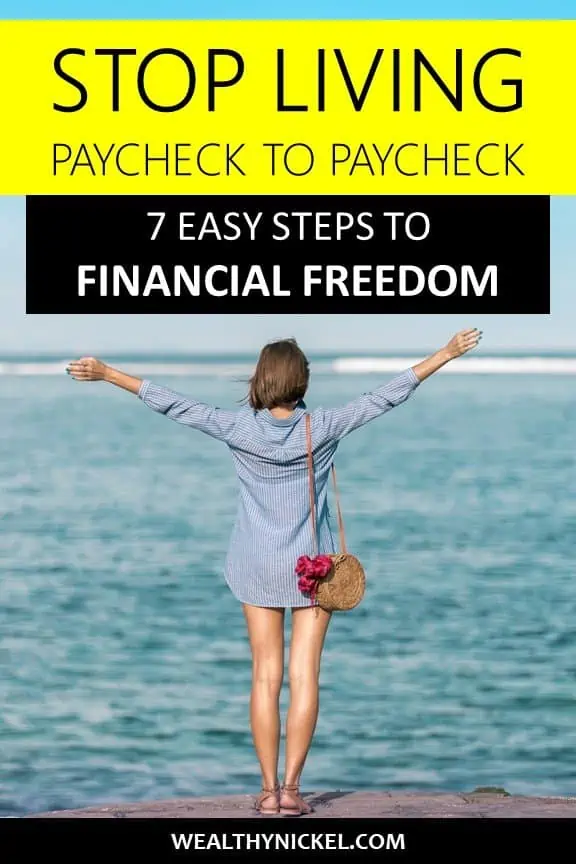Personal finance is a complicated subject, and the path to financial freedom littered with those who have given up somewhere along the way.
At its root, money is simple. Everyone knows how to become wealthy. Make more money, spend less than you earn, get rich!
It reminds me of the Underpants Gnomes from South Park with their brilliant business plan:
Phase 1 – Collect underpants
Phase 2 – ?
Phase 3 – Profit!
Financial Freedom: Simple But Not Easy
While simple on its face, the complexity lies in that middle step. Or said another way – it’s not enough to know how to get rich, you actually have to make a plan and execute it.
Even when it gets hard.
Even when it seems like you aren’t making progress.
Even when everyone around you doesn’t understand.
The path to financial freedom is simple, but it’s not easy. If it were easy, everyone would be a millionaire, right?
That said, I know if you’re here reading this you have what it takes to become financially free. You have the desire, fueled by your own personal story of why you want to get out of debt, or achieve financial independence so you can work when and where you want, or be able to raise your children in a more financially stable position than you grew up in.
If you stick around this blog, you can learn everything you need to know to achieve financial freedom. Not only the tools to financial health (making money, saving money, managing money), but how to get the right mindset. Whether you know it or not, you have preconceived notions about money that may need to change before you can actually break through the wall that is holding you back. Just like physical fitness, financial fitness is 10% knowledge and 90% actually putting in the work.
While taking action is up to you, I hope I and the Wealthy Nickel community can help rally around and support you on the journey.
There is an ancient Chinese proverb (at least that’s the origin the internets attributes it to) that says “the best time to plant a tree was 20 years ago; the second best time is now.” This applies 100% to your journey to financial freedom. Whether you are 20 years old or 60, you cannot change the past. But you can decide to get serious about your financial future right now.
Below are the 7 simple (but not necessarily easy) steps to financial freedom. So what are you waiting for?
Step 1: Make a Plan (Find Your Why)
This is where it all starts. Before you run out and get a side hustle or cut the cable, you need to spend some time thinking through WHY you want to get your financial life under control.
Things will get hard and you will lose your motivation – there’s a reason 80% of New Year’s resolutions fail by February. If you don’t have a clear purpose, you will inevitably give up somewhere along the way.
Grab a cup of coffee, sit down with a pen and paper, and write out why you want to achieve financial freedom. You don’t have to pen the next great economic masterpiece – it can be really simple. Maybe you want the freedom to quit your job and work on your passion project that doesn’t pay as well. Maybe you just want to stop feeling the stress of not knowing if you have enough to pay the bills from paycheck to paycheck.
Step 2: Track Your Spending (Where are You Now)
Think of this as the research phase. You can’t know where you’re going until you know where you are. If you’ve been living on the edge with a few dollars in your bank account separating you from complete destitution and you can’t figure out why, now’s the time to learn.
Before I started tracking my spending, I assumed I knew generally how much I was spending in various categories. Boy was I surprised when I actually added it up. I don’t have any hard proof, but anecdotally I think EVERYONE spends more on groceries and eating out than they think they do. Add it up. You will be shocked.
Step 3: Make a Budget
I have a confession…I hate budgeting. It’s the ultimate scarcity mindset. Time to sit down and make the budget – what should I deprive myself of this month?!
This is where the rubber meets the road. If you didn’t establish a strong “why” is Step 1, you are not going to make it very far once you start living on a budget.
There are a lot of personal finance tips like this that are easy to say but hard to implement.
But here is a simple mindset shift that helped me learn to love budgeting: budgeting is nothing more than making my spending align with what I truly value. If I say I value giving to my church or a local community cause and yet come up empty every month because I blew $300 going out to lunch with my co-workers every day, then I need to re-prioritize my spending.
Controlling your spending in one category allows you extra room in another. You don’t have to cut your spending down to the bone in every single aspect of your life in order to get to financial freedom (and if you do, I would highly suggest working on increasing your income as soon as possible). But you do you have prioritize spending and figure out what you’re willing to sacrifice so you can spend on what you care about. And obviously a big part of your budget should be going into savings – paying your future self first.
RELATED: Dave Ramsey’s Budget Percentage Guidelines
Step 4: Establish an Emergency Fund
If you hit a pothole and blew a tire on the way to work, would that completely decimate your budget? If so, you are living too close to the edge and putting way too much unnecessary stress on yourself.
According to a recent survey, over 60% of Americans couldn’t come up with enough money to cover a $1000 emergency. You should not be in that 60%!
If you’re just getting started with getting your finances under control, I recommend you scrimp, save, borrow, and steal (ok don’t borrow or steal) to put $1000 into an emergency fund. And then use it for EMERGENCIES ONLY. That outfit you’ve had your eye on that just went on sale? Not an emergency. IPhone 6000+ with the upgraded Siri who reads your mind? Not an emergency. Water heater catastrophically fails and your house suddenly turns into a very large, very expensive fish tank? Not an emer…ok, that one counts as an emergency. (P.S. Water heaters only fail catastrophically. Ask me how I know.)
RELATED: Emergency Fund Examples – Are You Prepared for These 7 Financial Disasters?
Step 5: Pay off Debt
The first 4 steps were all about breaking the consumer debt cycle so you aren’t constantly financing your lifestyle with high interest credit card debt. Now you can start attacking the debt balances and make a plan to pay them off. This could be credit card debt, student loan debt, medical debt, etc. Lay out all your credit card and loan statements and figure out how much you owe.
There are a lot of different methods to pay down debt. Two of the main ones are the debt snowball (advocated by Dave Ramsey) and the debt avalanche (advocated by math nerds). In the debt snowball, you pay off the lowest balance loan first. In the debt avalanche, you pay off the highest interest rate loan first. While technically the debt avalanche will pay off your total debt faster, I generally recommend the debt snowball because it allows you see your progress and get some early wins. As you pay off some of your small balances, you can use that money and apply even more to the next highest debt, and so on.
Related: Good Debt vs. Bad Debt – What’s the Difference?
Step 6: Invest for the Future
This is where the fun starts. Instead of feeling powerless to control your future retirement and financial security, you’ve mastered the ability to live on a budget and paid off your debt. This is the start of financial freedom.
In this step, you can learn all about 401(k)s, IRAs, stocks, bonds, real estate, bitcoin (ok, probably not bitcoin). There is an overwhelming amount of information out there about how to “beat the market” and “invest like a pro”. I’m here to tell you that investing is actually really simple. If you’re just getting started, you can invest in a single index fund and beat 90% of the investment professionals out there. Or you can diversify a little bit while still keeping it simple with something like this 3 fund portfolio. Keep it up and the power of compounding will grow your net worth faster and faster over time, getting you closer to your financial freedom goals.
Related: 401k Mistakes that Cost You $100,000+ In Retirement
Step 7: Leave a Legacy
Once you master making your money work for you, the sky is the limit. Keep working toward your goals, whether that is a net worth figure, or a passive income amount. Achieving financial freedom is not an end in itself. Early retirement doesn’t mean just sipping cocktails on the beach. It opens up the door no longer trade your time for money and make a bigger impact on the world. Want to spend more time with your kids? Volunteer with a local refugee ministry? Start your own local business?
Related: Why We Tithe – The Compound Giving Effect
Anything is possible once you have learned the secrets to financial freedom!
Bonus: How to Make More Money
Bonus: How to Save More Money
Bonus: Advanced Strategies to Retire Early
Andrew Herrig is a finance expert and money nerd and the founder of Wealthy Nickel, where he writes about personal finance, side hustles, and entrepreneurship. As an avid real estate investor and owner of multiple businesses, he has a passion for helping others build wealth and shares his own family’s journey on his blog.
Andrew holds a Masters of Science in Economics from the University of Texas at Dallas and a Bachelors of Science in Electrical Engineering from Texas A&M University. He has worked as a financial analyst and accountant in many aspects of the financial world.
Andrew’s expert financial advice has been featured on CNBC, Entrepreneur, Fox News, GOBankingRates, MSN, and more.



You summed up the process quite nicely in this post! I like how you emphasized how you need to take action and have a reason to be taking those actions. I’ve noticed people in my own life that say they want to do something or even start doing something, only to give it up after a short time. Persistence is the easiest way to get ahead on so many things!
It is so simple, isn’t it?
I’m amazed by how many people follow none of these tips. They reach age 60 and struggle at work and yet have no options. Out of control spending. Deep in debt. No plan. No savings.
Ah yes, it is simple, but not at all easy.
I hope some of your readers will be inspired and follow this excellent advice.